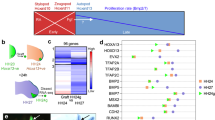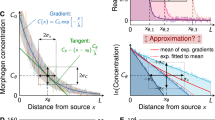Abstract
A group of mesenchyme cells at the posterior margin of the developing wing—the polarizing region—can have a dramatic effect on the pattern of structures which develop across the antero-posterior axis of the limb. If one grafts a polarizing region to the anterior margin of a wing bud so that this bud now has one polarizing region at the anterior margin and one at the posterior margin, the wing that develops has duplicated structures across the antero-posterior axis in mirror-image symmetry1–3. That is, the normal pattern of digits 2 3 4 (reading from anterior to posterior) becomes 4 3 2 2 3 4. The ability of the polarizing region to specify additional digits from adjacent tissue can be progressively attenuated by γ-ray radiation4. If this attenuation is caused by progressively fewer cells remaining viable to signal, there should be a quantitative relationship between the number of polarizing cells used and the digit specified next to the graft. Here, two tests are reported which confirm this idea. The results suggest that the apical ridge cooperates with a small number of polarizing region cells in a monolayer to specify structures across the antero-posterior axis of the wing.
This is a preview of subscription content, access via your institution
Access options
Subscribe to this journal
Receive 51 print issues and online access
$199.00 per year
only $3.90 per issue
Buy this article
- Purchase on Springer Link
- Instant access to full article PDF
Prices may be subject to local taxes which are calculated during checkout
Similar content being viewed by others
References
Saunders, J. W. & Gasseling, M. T. in Epithelial-Mesenchymal Interactions (eds Fleishmajer, R. & Billingham, R. E.) 78–97 (Williams & Wilkins, Baltimore, 1968).
Tickle, C., Summerbell, D. & Wolpert, L. Nature 254, 199–202 (1975).
Tickle, C. in Development in Mammals Vol. 4 (ed. Johnson, M. H.) 101–137 (North-Holland, Amsterdam, 1980).
Smith, J. C., Tickle, C. & Wolpert, L. Nature 272, 612–613 (1978).
Saunders, J. W. in Vertebrate Limb and Somite Morphogenesis (eds Ede, D. A., Hinchliffe, J. R. & Balls, M.) 1–24 (Cambridge University Press, 1977).
Author information
Authors and Affiliations
Rights and permissions
About this article
Cite this article
Tickle, C. The number of polarizing region cells required to specify additional digits in the developing chick wing. Nature 289, 295–298 (1981). https://doi.org/10.1038/289295a0
Received:
Accepted:
Issue Date:
DOI: https://doi.org/10.1038/289295a0
This article is cited by
-
Santos syndrome is caused by mutation in the WNT7A gene
Journal of Human Genetics (2017)
-
A strategy to discover new organizers identifies a putative heart organizer
Nature Communications (2016)
-
Biased Polyphenism in Polydactylous Cats Carrying a Single Point Mutation: The Hemingway Model for Digit Novelty
Evolutionary Biology (2014)
-
Digit patterning during limb development as a result of the BMP-receptor interaction
Scientific Reports (2012)
-
Gene Replacement Strategies to Test the Functional Redundancy of Basic Helix–Loop–Helix Transcription Factor
Pediatric Cardiology (2010)
Comments
By submitting a comment you agree to abide by our Terms and Community Guidelines. If you find something abusive or that does not comply with our terms or guidelines please flag it as inappropriate.



